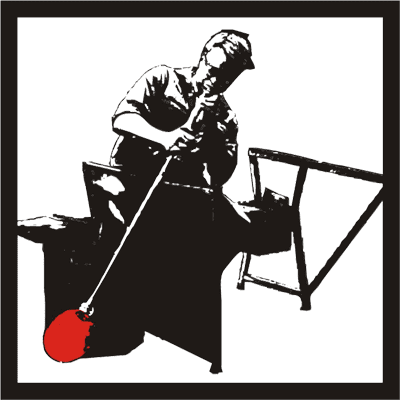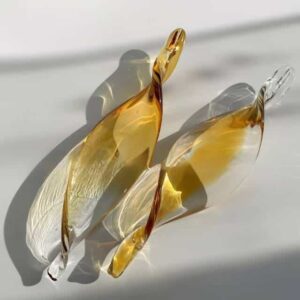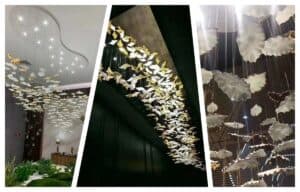Understanding the Value: A Guide to Pricing Artisanal Blown Glass
Published on 2023年 8月 25日 by iartglass

Handblown glass is a cherished artform that produces stunning and unique pieces. But with so much time, skill, and artistry invested into each piece, how can collectors understand and justify the pricing? This guide explores the key factors that contribute to blown glass pricing.
The Intensive Creative Process
Every handblown glass piece involves an extensive creative process from conceptual design to physical formation. Master artisans invest years honing their craft. The intricate glassblowing process requires both technical precision and artistic vision to shape molten glass into a beautiful objet d’art. Even seemingly simple pieces can take days of meticulous teamwork between the gaffer, assistant, and master artisan.
So first and foremost, the pricing reflects the intensive labor involved. While machines can produce mass quantities of glass, they cannot replicate the nuances of handcrafted artistry.
Rare Skills and Mastery
In addition to the demanding creative process, blown glass pricing is driven by the rarity of skills and mastery involved. Glassblowing is an ancient technique that very few artisans fully master today.
The highest level of artistry commands premium pricing. For example, master blowers in Italy’s Murano glassmaking region develop their skills over decades. Their exceptional pieces with intricate patterns, controlled bubble effects, and brilliant colors reflect generations of Localized mastery.
So as you evaluate pricing, consider the specialized skills and mastery required to achieve the visual effects and quality. Superior artistry and rarity drive higher values.
Unique Creative Vision
Every handblown glass piece also represents the unique creative vision and style of the artisan. Even using the same techniques, no two pieces will be identical.
Some of the most coveted works come from artisans with a bold creative voice and flawless execution. Their one-of-a-kind pieces achieve a distinctive aesthetic unlike any other.
So as you appreciate the pricing, consider also the distinct perspective and artistry of the glassblower. Their imagination and skill define the character of each piece.
Limited Production
While factory glassware is mass-produced, artisanal blown glass involves very limited production. Each piece is individually handcrafted rather than cast from a single mold. Even large installations comprise dozens of unique individual components.
This scarcity adds to the value and pricing. When only a few examples of a design exist worldwide, it becomes more precious. Some artists may produce no more than 10 of a specific design.
So limited production runs mean fewer opportunities to own a particular work. In economic terms, supply is severely limited relative to potential demand.
Customization and Bespoke Details
Another key factor in pricing is the extent of customization and bespoke details lavished on the piece. Commissioning original art glass offers opportunities for personalization and collaborative design.
The more custom inputs, the greater effort required by the artisan. Some high-end clients even request incorporating precious metals or rare glass colors. This takes more time, care, and sourcing of specialty materials.
So personalized art glass bears the value of tailored artistry and attention to detail, often making it a priceless keepsake.
Reputation and Renown
An artisan’s reputation and renown also contributes to the market value of their glasswork. Internationally recognized glass artists with critical acclaim and prestigious commissions can warrant premium pricing for their most important works.
For example, Dale Chihuly has exhibited in museums worldwide. His site-specific installations sell for millions. While less known emerging artists sell at lower price points until establishing a reputation.
So an artist’s credentials and fame play a role in pricing levels. But remember even legends started somewhere, so an emerging artist’s early works can represent good future value.
Quality of Glass
The quality and rarity of the glass medium itself impacts overall pricing. Fine art glass uses higher-grade molten glass as its canvas.
Factors like purity, texture, and color complexity distinguish fine art glass from standard industrial glass. For example, Murano glass is specially formulated on the Venetian island. Its unique chemistry allows vivid colors and intricate patterns.
So using superior source glass materials allows artisans to achieve visual effects not possible otherwise. This boosts quality and pricing.
Fragility and Special Care
As a fragile medium requiring special care, handblown glass warrants pricing that reflects its vulnerability. Professional handling, shipping, insurance, and display protect investment value. Sudden temperature changes can also cause breakage.
Once damaged, glass cannot be restored. So collectors must consider long-term maintenance needs. Proper cleaning, storage, and handling prevent damage and deterioration. Required precautions also add to costs and value.
Personal Expression and Emotional Connection
Beyond tangible factors, personal expression and emotional connection remain at the heart of art glass appreciation. The pricing represents far more than labor costs alone.
Art glass makes a profoundly moving gift. A handblown piece evokes meaning, memories, and creativity. It elicits imagination and brings joy for generations. The intrinsic emotional value makes it precious beyond any price tag.
So when you encounter the perfect art glass creation, reflect on its personal significance. Cherish the lasting fulfillment born of inspiring artistry.
An Artistic Legacy
Ultimately, handblown glass deserves appreciation as an artistic legacy. Each creation represents the enduring passion, imagination, and skill of its maker.
Limited and masterfully crafted, art glass is far more than decorative. It embodies precious vision meant to be absorbed, enjoyed, and preserved for posterity. This inherent worth transcends monetary value.
So while market factors shape pricing, the true essence of handblown glass remains its imaginative spirit. Let investment in this artistic legacy bring inspiration to your life or the lives of loved ones for years to come.
As you explore the special world of art glass, keep this guide in mind when evaluating pieces. Price reflects intensive artistry, rarity, and fragility. But also listen to your inner voice of appreciation. Having a personal resonance that sparks joy and imagination matters most of all. Let the creativity embodied in hand blown glass become part of your own lifelong inspiration.




